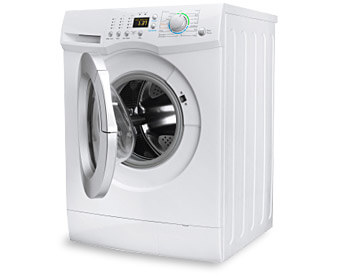
A washing machine (a.k.a. washer, laundry machine) provides an efficient way to clean loads of laundry including clothing and home textiles.
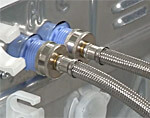
Check your washing machine's water hoses for signs of wear or weakness a few times each year. If you discover any cracks or blistering, replace the hose. Any damage could cause a leak or burst – and extremely expensive flood damage in your home.
Most manufacturers recommend replacing the hoses every five years. For more peace of mind, use high-quality, stainless steel hoses.

In the event that your washing machine's fill hoses burst or water level switch malfunctions, you'll have instant water damage in the room.
These two products can prevent this:

Follow the owner's manual's instructions for appropriate loading sizes. Oversized loads will throw the machine off balance and that will lead to problems.
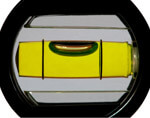
It's abnormal for washing machines to vibrate the floor and walls of your laundry room. If your washing machine is not exactly level, with all four legs on the floor, it may rock back and forth and vibrate strongly.
It's best to keep the machine as close to the floor as possible. The closer the machine sits to the floor, the less it will vibrate. The front legs are adjustable with a locknut. Position the legs at the desired height and tighten the lock nut against the body of the machine so that the legs cannot rotate. Some models also have adjustable legs in the rear, too. Follow the same process for adjusting those.
It is more common for machines to have self-adjusting rear legs. Ask someone to assist you with this. Tilt the machine forward on its front legs so that the rear legs are three to four inches from the floor. When you set the machine back down to rest all on all four legs, the legs should adjust automatically. If you find that they are not level, tilt the machine forward again and tap on the rear legs with the handle of a hammer to loosen them. Another option would be to purchase leveling leg pads to assist in noise reduction.
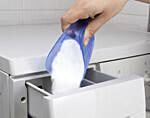
Regardless of what's recommended on detergent packaging, follow your owner's manual for the manufacturer's recommended amount of detergent. If you have soft water you will need to greatly reduce the amount of soap used. Rule of thumb is a thin layer of suds in the wash cycle. If there is too many suds, the rinse cycle may not get them all out.

It's common for detergent residue to build up inside of washing machine tubs. Use a cleaner once per month to keep high-efficiency washing machines free of odor-causing residue.
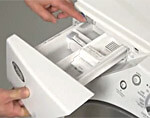
Gooey in nature, liquid fabric softener is known to gum up along fabric softener dispensers. Use a damp rag and hot water to clean the dispenser periodically. If you're using fabric softener in an agitator you can dilute the softener with water to make it flow better and not spray in the agitator.
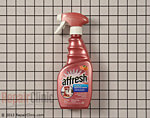
Spilled detergent, stain remover and fabric softener dry to a sticky mess. This all-purpose cleaner and a rag will make cleaning easy.
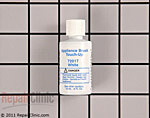
Prevent rusting by taking care of gashes and scrapes right away using touch-up paint.
Yes. It is very important for washing machines to be level for proper operation.
Absolutely. In fact, the higher initial cost of a front loader can be recovered in just a few years through water, sewer, drying time, and soap-usage savings.
The warm water for your washer is simply a mixture of the hot and cold water available from your home. If the hot water entering the machine isn't very hot, the warm is actually cool. Also, in northern climates, during winter months, the cold water entering the unit may be significantly colder than in the summer, which causes the warm water to be cooler. Some newer washers have temperature sensors to monitor the incoming water temperature. The factory settings may be different than what you are used to.
In other cases, the water inlet valve may be restricted, or there may be sediment on the screen, that blocks the input of the hot water. Check out the washing machine troubleshooting and repair help information for additional information.
For a top loader, a general rule of thumb is to lay clothes loosely inside the washer until they reach the top of the agitator. For a front loader, fill it until it's full, with minimal compression of the clothes.
This is usually an indication that you're using too much detergent for the clothes you are washing. Try reducing the amount of detergent by half. Then, if the clothes do not appear to be as clean as they should be, increase the amount slightly for each load, until the clothes do get clean.
During a wash cycle, clothes often turn inside out during the agitation cycle. Turning the clothes inside out first may be easier on the clothing. It limits abrasion on the "good" side of the fabric, reducing "pilling" and extending the life of some fabrics such as corduroy. In addition, any embroidery, decals, and so on are better preserved. It should not affect the performance of the cleaning action to have the clothes inside out during wash.